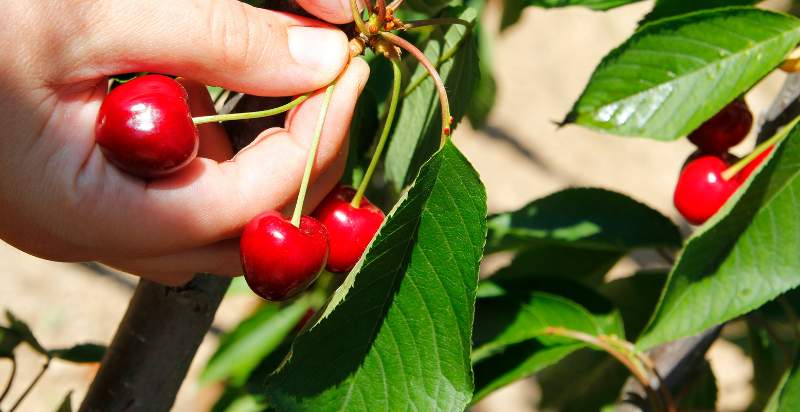Cherries are one of the most popular fruits in the world. They come in a variety of shapes, sizes, and colors. There is no definitive answer to what makes a cherry so beloved because there are so many different types of cherries available. This article will explore some of the different varieties, their health benefits, and how best to store them for maximum flavor and nutrition. Measuring a mere 1 to 2 centimeters in diameter, its round or oval silhouette echoes the familiar shape of a nance fruit.
What are Cherries?
Cherries are stone fruit that grows on trees in temperate climates worldwide. They come in wide varieties, including sweet and sour cherries, and are usually enjoyed fresh or processed into jams, jellies, syrups, and other products. Sour cherries contain more antioxidants than sweet cherries and have a tart flavor. Sweet cherries have higher sugar content and a sweeter taste.
History and Origin of Cherries:
Cherries have a long history and are considered one of the oldest domesticated fruits. They likely originated in Asia Minor, where the ancient Greeks, Romans, and Egyptians cultivated them. Wild cherries are still growing in many parts of Europe and North America. The first recorded mention of cherries in English dates back to 1548.
Varieties of Cherries:
The two main cherries are sweet (or dessert) and sour (or tart). Sweet cherries are larger with darker skins and juicier flesh than their sour counterparts. Sour cherries have more acidic flavors and usually contain fewer calories, but they are also more difficult to find in stores.
Health Benefits of Cherries:
Cherries contain several essential vitamins and minerals that are beneficial for overall health. They are rich in vitamin C and beta-carotene, which help the body absorb iron, boost immunity and protect against cellular damage. Additionally, cherries are a good source of potassium, magnesium, zinc, calcium, and fiber. These minerals have been linked to supporting cardiovascular health and regulating blood pressure levels.
Cherries also have considerable anti-inflammatory capabilities due to their high content of antioxidant compounds like anthocyanins. Studies suggest eating more cherries can reduce inflammation caused by chronic conditions such as arthritis or asthma.
Furthermore, adding cherries to your diet may increase longevity due to their antioxidants, which help protect against free-radical damage and other age-related issues. Due to their melatonin content, cherries are believed to improve sleep quality, mood, and energy levels. Eating cherries may even reduce belly fat, making them a valuable part of any weight loss diet plan.
Nutritional Value of Cherries:
Cherries are delicious and nutritious fruit with numerous health benefits. A cup of cherries provides an impressive array of vitamins, minerals, antioxidants, and other beneficial compounds.
One cup of fresh or frozen cherries contains approximately:
- 84 calories
- 21 grams of carbohydrates
- 3 grams of dietary fiber
- 1 gram of protein
- 15 percent of the daily value for vitamin C
- 10 percent of the daily value of potassium
- 8 percent of the daily value of copper
- 6 percent of the daily value of iron
In addition to these essential nutrients, cherries contain various plant compounds that may promote health. Anthocyanins are responsible for cherries’ red, blue, and purple colors. They are powerful antioxidants that provide anti-inflammatory benefits. Cherry intake has also been associated with a lower risk of chronic diseases like diabetes and heart disease.
Eating a cup of cherries can help to boost your immune system, reduce inflammation, improve heart health, and even aid in weight loss. Cherries make for a great snack choice or can be used as an ingredient in various recipes.
Uses of Cherries:
Cherries are delicious and versatile fruit with many culinary and health benefits. They can be eaten raw, cooked, or preserved for later use.
In the kitchen, cherries can be used in sweet dishes such as pies, tarts, muffins, cakes, and jams. For savory dishes, they add a lovely tartness to sauces and stews. Dried cherries also make an excellent snack or topping for salads or oatmeal.
Cherries contain many vitamins and minerals that help promote good health. They are rich in antioxidants like anthocyanin, which can protect cells from damage caused by free radicals. Cherries also reduce inflammation in body tissues due to their high levels of anthocyanins and flavonoids.
The juice of cherries can also be beneficial for health. It is high in vitamin C, beta-carotene, potassium, and fiber. Drinking cherry juice may reduce the risk of heart disease, reduce inflammation and improve digestion.
Cherries are a great addition to any diet and can easily be incorporated into many recipes. They have many uses beyond just being eaten fresh or as a snack.
How to Plant Cherries?
Cherries are delicious fruit packed with plenty of nutritional health benefits. If you want to get into gardening and love cherries, planting them can be a rewarding experience! This article will cover all the basics of planting cherry trees, from selecting and preparing your soil to taking care of your tree after it is planted. We’ll also discuss some common problems you may encounter along the way. By the end of this article, you should have a clear idea of what it takes to grow cherry trees in your garden or orchard successfully.
Choosing Your Variety:
When choosing a variety for growing cherries, there are several factors to consider. First, you’ll want to consider the climate in your area, as some varieties are better suited for cooler or warmer temperatures. You should also consider what type of fruit you want from your trees; tart cherries are more popular for cooking and baking, while sweet cherries are usually preferred for eating.
Next, you’ll want to consider how much space you have available. Depending on the variety chosen, cherry trees can grow quite large when fully mature. Finally, consider any disease resistance needs that may be necessary for your area – certain varieties are resistant to various diseases and pests that can cause damage if left unchecked.
Preparing Your Soil:
Once you’ve chosen your variety, the next step is to prepare the soil. The best soils for cherry trees are well-draining and loamy. If your soil is heavy with clay or sand, you may need to add organic matter, such as compost, to improve its structure. You’ll also want to ensure that your soil has a pH between 6.0 and 7.5 – if it’s too acidic or alkaline, you may need to amend it with lime or sulfur accordingly.
Planting Your Tree:
Once your soil is prepared, you can begin planting your tree! Before digging the hole for your tree, ensure there are no large rocks or other debris in the area where you plan to plant. Then, dig a hole that’s twice as wide and just as deep as the root ball of your tree. Place the tree in the hole, fill it with soil, and pack it down firmly around the roots. Water your newly planted cherry tree well and give it plenty of shade until it’s established.
Caring for Your Tree:
Once your tree is planted, you’ll need to ensure that it receives adequate care throughout its lifetime. First, you should water your tree regularly – at least once every week or during dry periods. Additionally, it would help if you pruned away any dead or broken branches annually to promote healthy growth. If necessary, provide additional nutrients such as fertilizer twice a year. Finally, protect your tree from any potential pests or diseases by using the appropriate treatments as soon as you notice any signs of trouble.
Growing cherry trees requires time and effort but can be a rewarding experience for those willing to do the work. Following these steps, you should have no problem getting started with your cherry tree garden! Remember that every variety is different, so research yours thoroughly before beginning the planting process. With proper care and attention, you’ll soon be enjoying delicious cherries straight from your backyard.
How to Care for and Grow Cherry Trees?
To ensure a successful harvest of cherries, there are several steps you should take to care for and grow your cherry trees. Once the tree is planted, it’s important to give it plenty of water and fertilizer. Watering weekly or biweekly during dry periods will help promote healthy growth. Additionally, supplementing with fertilizer twice a year can provide additional nutrients to help your tree thrive.
It’s also important to prune away any dead or damaged branches each year to encourage new growth and avoid overcrowding of the branches. This helps keep the tree healthy and improves air circulation, reducing the risk of disease and pests. Finally, monitor your cherry trees for signs of disease or insect damage, as these can quickly spread and cause serious harm to the tree. If you notice any trouble, take care of it as soon as possible with appropriate treatments.
Following these steps, you’ll have no problem growing delicious cherries from your backyard orchard! With a little time and effort, you can enjoy sweet, juicy cherries straight from your tree for many years.
Preventions from Pests and Diseases:
Pests and diseases can be major problems when growing cherries. It is important to monitor the tree for signs of infestation or disease to prevent this. If you notice any trouble, take action immediately with the appropriate treatments. Additionally, proper pruning can help keep your tree healthy by encouraging new growth and reducing the overcrowding of branches which improves air circulation and helps protect against pests and diseases.
Finally, you can apply protective sprays during the season to further reduce the risk of disease or pest damage. Be sure to use a product specifically designed for cherry trees to ensure that it will work effectively. By following these simple steps, you can ensure that your cherry trees remain healthy and productive for many years.

Harvesting Your Cherries:
When your cherry tree is ready, it’s time to start harvesting! First, you should identify the ripest cherries, which will give you the best flavor. You can easily tell when a cherry is ripe by gently squeezing it – if it’s soft enough to be slightly squished, then it’s good to go. Once you have identified the ripe cherries, apply gentle pressure with your thumb and forefinger or use a small pair of pruning shears to snip them away from the branch carefully.
It’s important to harvest promptly, as leaving fruit on the tree for too long can cause it to become overripe and start to rot. Once you’ve harvested your cherries, enjoy them as soon as possible to take advantage of their fresh flavor!
Finally, ensure that you clean up any fallen fruit or branches from the ground around your tree to reduce the risk of disease. You should also check regularly for signs of pests or diseases so that you can act quickly if necessary. By taking these steps, you will keep your cherry trees healthy and productive for years.

How to Store Homegrown Cherries?
Once you’ve harvested your cherries, it is important to store them properly to maintain their freshness. The best way to store homegrown cherries is in the refrigerator. Place your cherries in a plastic container or basket in the coldest part of the refrigerator – usually near the back wall. Suppose you do not have room for your cherries. In that case, you can freeze any that you won’t use immediately by spreading them out on a baking sheet lined with parchment paper and freezing them until solid before transferring them to an airtight container or resealable bag.
Freshly picked homegrown cherries should last up to two weeks when stored properly in the fridge and up to six months when frozen. When ready to use your cherries, take them from the refrigerator or freezer and let them come to room temperature before eating.
Following these easy steps, you can enjoy homegrown cherries for many months after harvesting!

How to Use Cherries in your Day-To-Day Life?
Cherries are an incredibly versatile fruit and can be used in various recipes to bring a sweet and tart flavor. Here are some ideas of how you can introduce cherries into your day-to-day life:
- Add chopped cherries to salads, yogurt parfaits, oatmeal, or smoothie bowls.
- Make a cherry salsa as an alternative to tomato for topping tacos or nachos!
- Dried cherries make for an excellent snack on the go – try them with some dark chocolate chips for a delicious, guilt-free treat!
- Make your homemade cherry jam, compote, or jelly for spreading on toast, pancakes, or waffles.
- For a refreshing summer drink, blend cherries with ice and your favorite fruit juice for a cherry smoothie.
- Create an indulgent dessert by combining cherries with your favorite cake, cookie, or pie recipe.
- Add some color to your dinner plate with roasted cherries as part of an entrée like pork chops or grilled salmon.
- Make a delicious cherry-based sauce or glaze to pour over chicken or fish dishes!
- Top off homemade ice cream sundaes or frozen yogurt parfaits with chopped fresh cherries for extra flavor and texture.
- Finally, try making your cherry cordial or liqueur for an adult treat.
No matter how you incorporate cherries into your daily life, you can be sure that they will bring a touch of sweetness and flavor! Enjoy.

Potential Risks from Cherries:
When consuming cherries, it is important to remember that there are potential risks associated with the fruit. Eating too many cherries can cause digestive issues and stomach discomfort. Additionally, people with certain allergies may have adverse reactions when consuming cherries. Pesticide residues on the skin and traces of bacteria on the surface of the cherry can also present a health risk if they are not washed properly before consumption.
Finally, watch out for pit fragments in canned or frozen cherries; these could represent a choking hazard. You should speak to your doctor before introducing large amounts of cherries into your diet if you have any underlying medical conditions or concerns about potential health risks. In general, moderate consumption of fresh, organic cherries is a safe and healthy choice.
Conclusion:
Cherries are delicious and versatile fruit that can be enjoyed in many different ways. When consuming cherries, it is important to consider potential risks associated with the fruit, such as digestive issues, allergies, and bacteria or pesticide residue. You should also speak to your doctor before introducing large amounts of cherries into your diet if you have any underlying medical conditions or concerns. With proper storage and safe preparation methods, homegrown cherries can last for up to two weeks when stored in the refrigerator and up to six months when frozen.
- Everything You Wanted to Know About Red Tamarillos - June 2, 2025
- A Guide to Tulips: Everything You Need to Know & More… - June 2, 2025
- Guanabana: Description, Flavor, Benefits, And Uses - May 27, 2025

5 thoughts on “What are Cherries? How to Plant, Grow, and Harvest Cherries ”
Comments are closed.